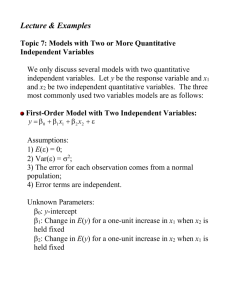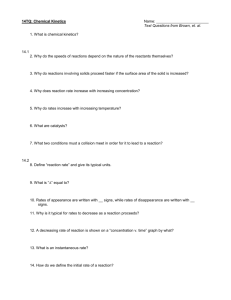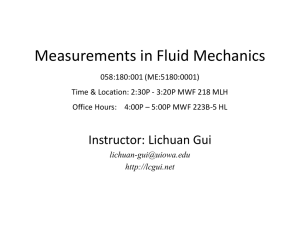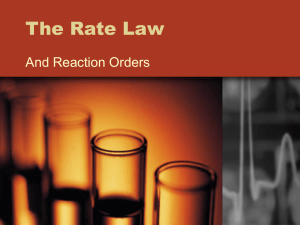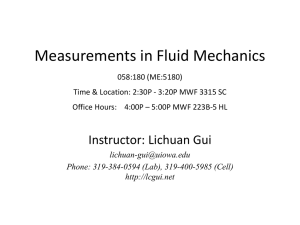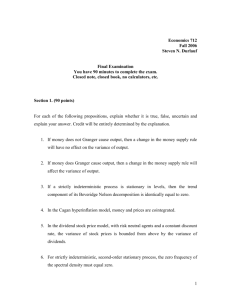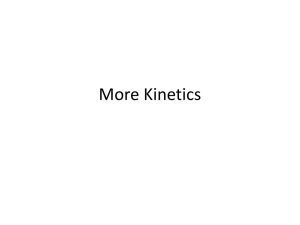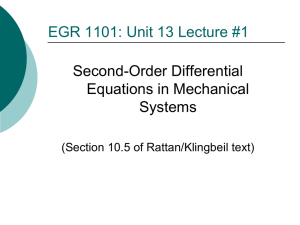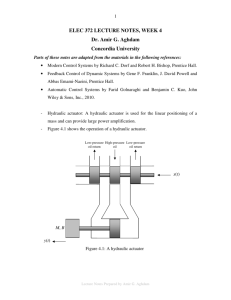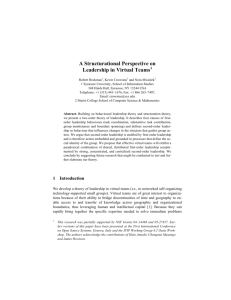Topic 6 - Pegasus @ UCF
advertisement
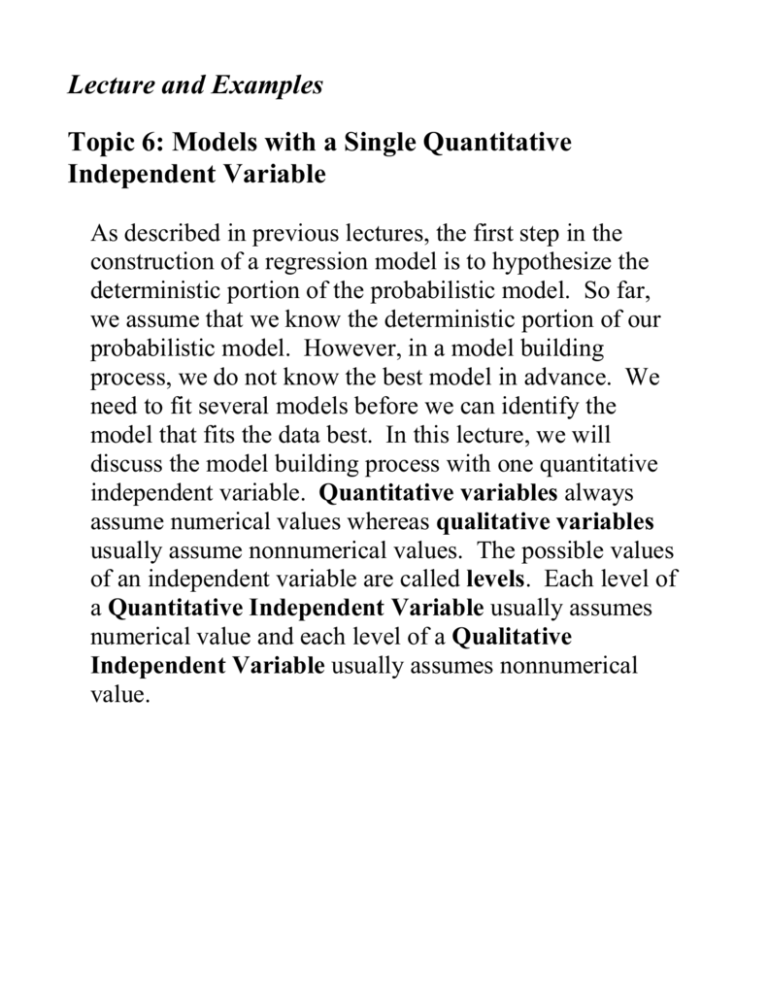
Lecture and Examples Topic 6: Models with a Single Quantitative Independent Variable As described in previous lectures, the first step in the construction of a regression model is to hypothesize the deterministic portion of the probabilistic model. So far, we assume that we know the deterministic portion of our probabilistic model. However, in a model building process, we do not know the best model in advance. We need to fit several models before we can identify the model that fits the data best. In this lecture, we will discuss the model building process with one quantitative independent variable. Quantitative variables always assume numerical values whereas qualitative variables usually assume nonnumerical values. The possible values of an independent variable are called levels. Each level of a Quantitative Independent Variable usually assumes numerical value and each level of a Qualitative Independent Variable usually assumes nonnumerical value. Example 12.11: For each of the following independent variables, identify the variables as quantitative or qualitative. (a) Number of years experience (b) Gender of the employee (c) Rank of the employee (d) Weight (e) Height (f) Volume (g) Annual Household Income (h) Letter Grade Solution: Quantitative independent Variables: Number of years experience, Weight, Height, Volume, and Annual Household Income Qualitative Independent Variables: Gender of the employee, Rank of the employee, and Letter Grade The most common linear models relating the response variable, y, to a single quantitative independent variable, x, are models derived from pth-order polynomial. The formula for a pth-order Polynomial model with one independent variable is y 0 1 x 2 x 2 3 x 3 p x p . The deterministic portion of the model is y 0 1 x 2 x 2 3 x 3 p x p , where p is the order of the polynomial and 012, …, p are the unknown parameters. The random error portion of the model is and we make the following assumptions about the random error terms: E() = 0: the expectation of the random error term is zero; Var() = 2: the variance of the random error term is constant; The random error for each observation comes from a normal population; The random error term for each observation is independent. Usually, we only use the first-order, the second-order, and the third-order polynomial models. 3 First-Order Model: y = 0 + 1x + , where 0 is the y-intercept and 1 is the slope the line 4 Second-Order Model: y = 0 + 1x + 2x2 + , where 0 is the y-intercept, 1 is the shift parameter of the parabola, and 2 is the rate of curvature 5 Third-Order Model: y = 0 + 1x + 2x2 + 3x3 + , where 0 is the yintercept. 6 Example 12.12: Data in Table 12.8 comes from a highway safety study. Table 12.8 OBS 1 2 3 4 5 6 7 8 9 10 11 12 13 14 15 16 17 18 19 20 21 22 23 24 25 26 27 28 29 30 31 32 33 34 35 36 Y 34.8 37.0 37.8 38.0 35.6 38.4 39.6 38.7 37.0 37.9 38.1 38.1 40.8 43.6 47.7 49.2 53.0 52.9 54.9 55.8 54.6 54.4 56.3 55.5 46.4 45.9 47.0 49.5 52.4 53.5 53.1 51.4 45.8 44.5 46.2 45.6 X1 X1SQ 49.2 51.9 53.3 56.3 58.6 62.8 65.2 67.6 68.8 72.1 74.5 76.4 79.7 83.5 87.3 91.8 95.9 98.9 103.1 107.4 111.2 116.3 122.3 129.8 134.9 137.9 143.5 148.8 153.6 159.6 161.6 164.1 165.2 169.4 172.0 175.7 2420.64 2693.61 2840.89 3169.69 3433.96 3943.84 4251.04 4569.76 4733.44 5198.41 5550.25 5836.96 6352.09 6972.25 7621.29 8427.24 9196.81 9781.21 10629.61 11534.76 12365.44 13525.69 14957.29 16848.04 18198.01 19016.41 20592.25 22141.44 23592.96 25472.16 26114.56 26928.81 27291.04 28696.36 29584.00 30870.49 7 SAS Printout for First-Order Model: Model: EQ1 Dependent Variable: Y Analysis of Variance Source Model Error C Total Sum of Mean DF Squares Square 1 693.34483 693.34483 34 1026.58073 30.19355 35 1719.92556 Root MSE Dep Mean C.V. 5.49487 45.86111 11.98154 F Value 22.963 R-square Adj R-sq Prob>F 0.0001 0.4031 0.3856 Parameter Estimates Parameter Standard Variable Estimate Error INTERCEP 34.235006 2.59323884 X1 0.108144 0.02256762 T for H0: Parameter=0 13.202 4.792 Prob > |T| 0.0001 0.0001 8 SAS Plot for the 95% confidence interval for the fitted model: SAS Printout for the Second-Order Model: Model: EQ2 Dependent Variable: Y Analysis of Variance Source Model Error C Total Sum of DF Squares 2 1296.53234 33 423.39322 35 1719.92556 Mean Square 648.26617 12.83010 Root MSE 3.58191 Dep Mean 45.86111 C.V. 7.81035 Parameter Estimates Variable INTERCEP X1 X1SQ Parameter Standard Estimate Error -0.857497 5.38997832 0.829923 0.10629013 -0.003219 0.00046945 F Value 50.527 R-square Adj R-sq T for H0: Parameter=0 -0.159 7.808 -6.857 Prob>F 0.0001 0.7538 0.7389 Prob > |T| 0.8746 0.0001 0.0001 9 SAS Plot for the 95% confidence for the Second-Order Model: (a) Write a second order model relating the number of highway deaths for a year to the number of license vehicles. Solution: yˆ 0.86 0.83 x1 0.0032 x12 (b) Is there enough evidence to indicate that the first-order model provides enough information for the prediction of the number of annual highway deaths? Is there enough evidence to indicate that the second-order model provides enough information for the prediction of the number of annual highway deaths? 10 Solution: First-order model: Test: = 0 against 0 Test Statistics: Fc = 22.963 p-value: 0.001 Second-order model: Test: = = 0 against at least one i 0 Test Statistics: Fc = 50.527 p-value: 0.001 Both models are useful in prediction. However, the second order model is better. (c) Does the second-order term contribute information for the prediction of highway deaths? Solution: Test Hypothesis: Test: = 0 against 0 Test Statistics: tc = 6.857 p-value: 0.0001 Thus, the second-order term provides significant information to improve the prediction model. 11
